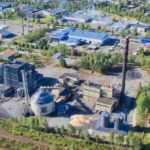The goals in energy production are increasing energy efficiency, phasing out fossil fuels and utilizing renewable energy sources. Ways to improve energy efficiency in energy-intensive sectors are, for example, the recovery of waste heat and cold and the utilization of heat recovery methods.
A heat pump can work as a cooling device or a heating device. The substance that flows inside the heat pump is called the working substance and it circulates in the process in a closed cycle. When vaporizing, the working substance binds heat and when it condenses, it releases heat. The function of the compressor is to increase the pressure and the function of the expansion valve is to drop the pressure back.
The compressor type is usually selected according to the process temperature and production level. A scroll compressor or a piston compressor are suitable for small-scale heat pump use. Kinetic compressors and screw compressors are used in large heat pumps.
The working materials used in heat pumps are subject to the exact provisions of EU legislation, and the use of some working materials is already prohibited. The working materials have different physical properties and the working material is selected in terms of the process in such a way that the highest possible efficiency (COP = Coefficient of Performance) is achieved. A good working substance has little impact on the environment, is non-toxic, is not flammable and does not cause corrosion.
Heat pumps can be divided into compressor-based heat pumps and absorption-based heat pumps. An electric refrigerator and air heat pumps are heat pumps based on compression technology, while a gas refrigerator, for example, is a heat pump/cooling device based on absorption technology.
